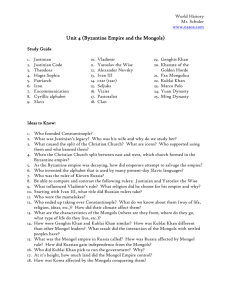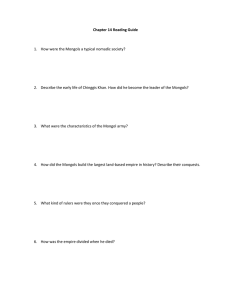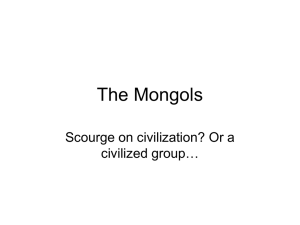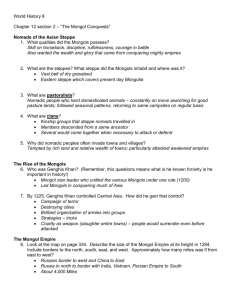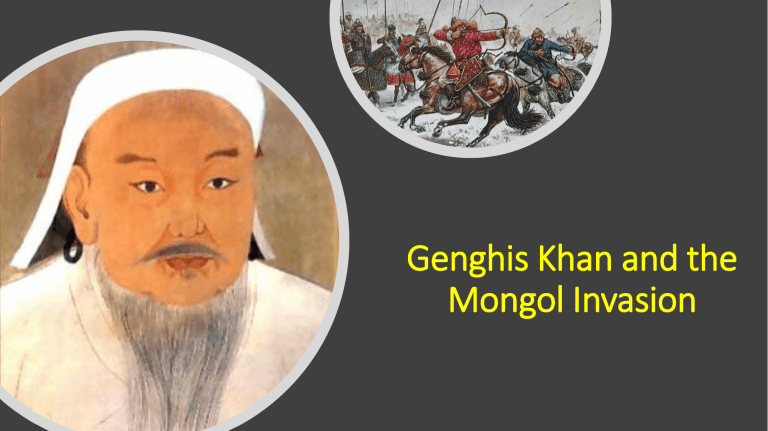
Genghis Khan and the Mongol Invasion The Genghis Khan mausoleum in Inner Mongolia • The historian’s Genghis Khan • Reasons for his success Outline • Extent of conquest • Invasion of eastern Europe • The successor states: the Khanates • Legacies • Questions and answers Khan’s invasions conquered most of Eurasia • Campaigns initiated in his lifetime include those against: • Qara Khitai, • Khwarezmia • Western Xia • Eastern Jin empire • How does one assess such a figure? The Khan’s empire • Reached as far west as Poland in Europe and the Levant in the Middle East. • Included raids into Medieval Georgia, Kievan Rus', and Volga Bulgaria. • These campaigns were often accompanied by large-scale massacres of the civilian populations • Especially in the Western Xia and Khwarazmian-controlled lands. The historian’s Genghis Khan • Widely differing views. • The European View: The Mongols: • were ruthless uncivilized barbarians. • were evil forces against Christians, Buddhists, Confucians, or Muslims. • were destroyers of civilizations. • The Chinese view: The Mongols: • Defeated the Han Chinese for the “first time in history…” • Were vulgar usurpers. • Overthrew the most cultured Chinese dynasty, the Song dynasty • To the extent that he was Chinese – he was the most successful conqueror in history The Mongolian view… • A revered figure in Mongolia • He embodies strength, unity, law and order. • Chinggis Khaan was also generous and loyal. • A highly charismatic man, he nonetheless also expected loyalty from everyone, including those who served his opponents. • MUCH more nuanced view: Modern western scholars • Genghis Khan was: • One of the finest military minds in history • A master in the strategic uses of terror • Someone who appreciated Chinese art, culture and civilization. Broader historical importance of Chinghis and his heirs Khan and his heirs Early life of Genghis Khan • Born in 1162 and grew up in in Delüün Boldog near the Onon River in Mongolia – not far from current capital Ulaanbaatar. The Olon River • May be buried there • Named Temüjin, Mongol for “blacksmith” • Father headed the Khamag Mongol confederation • Member of an elite family • After his father’s death, life was very hard The origins of the Khan’s empire • In 1206, Temujin was elected in the Gobi desert to rule Mongolia and he devoted himself to conquest. • His armies traveled both east and west to create the world’s largest empire ever. Khan, the military tactician • Key element: military intelligence. • Had n extensive network of spies • Had extensive information of an enemy before they engaged them in battle. • Their use of diplomacy was exceptional. • Psychological warfare. • Many peoples found it easier to submit than to resist. Genghis the conqueror • A brilliant organizer. • Merit Based Army • Master of feign and retreat • Again, emphasis on psychological warfare The keys to Chinggis’s success • Horses – basically an army on horseback • Technology • The bow • Gunpowder • Strategy & tactics • Gathering intelligence • Speed • Psychological warfare • Intimidate the enemy into surrendering The army lived on horseback. • Ate there, slept there, spent a week or more there. • Especially fought from there. • Opposing armies were not prepared for its speed, mobility and … brutality. The Mongolian horse What the horse made possible… • The Mongols were oriented around extreme mobility. • They carried their houses with them • Drank their own horse's blood to stay alive • Could travel up to 62 miles per day. • Had an elaborate mail system which allowed orders to be transmitted rapidly across Eurasia. • Mongol archers were very deadly and accurate The Mongol warrior’s standard kit • Battle axe • Curved sword known as scimitar • Lance • Two versions of their most famous weapon: the Mongol re-curved bow. • One of the bows was light and could be fired rapidly from horseback • The other one was heavier and designed for longrange use from a ground position. New weapons •The Mongols were skilled horsemen and mounted archers. •Their bows were the best of the time. •Their arrows could kill enemies at 350 yards •Heavier cavalry also used lances. Psychological warfare • Mongols had a deserved reputation for cruelty and ruthlessness. • Much of this was done for effect and looking ahead to the “next target.” • MAIN IDEA: • Put one city thru the wringer. • See ten surrender without a battle Chinggis promoted the idea of his cruelty and ruthlessness “The greatest happiness is to scatter your enemy, to see his cities reduced to ashes, to see those who love him shrouded in tears, and to carry off his wives and daughters.” A mass family grave in Yaroslavl, Russia. Whole families, communities and cities were wiped out • IN Yaroslavl, as many as nine burial pits were unearthed containing remains of more than 300 buried individuals who "died a violent death". • One mass grave was uncovered near a burned-down homestead beneath a demolished cathedral. • DNA showed most of them were in one family representing three generations. The Mongol Empire at its height Case #1: the destruction of Merv in Persia • HUGE KEY city on the Silk Road • Mongols came in Feb., 1221 AD • Siege and sack happened quickly • Entire population was put to the sword Merv today Case #2: Baghdad • Center of the Abbasid Caliphate • The LARGEST CITY in the world in the 12th century • Multicultural and very cosmopolitan • Another key link in the Silk Road In Baghdad, the House of Wisdom… • A library-academy-translation center • One of 36 libraries in the city • Scholars of different cultures and beliefs worked side by side translating texts from Greece, India, Persia and elsewhere into Arabic. • Caliph Al-Musta’sim refused to pay tribute to the Khanate to the north • Siege lasted 12 days • Sacking involved destruction of mosques, palaces, libraries, and hospitals. • Over 90,000 people killed • May also have destroyed the millenias-old system of canals Destruction of Baghdad in 1258 by the armies of Hulagu Khan • Destruction marked the end of the Islamic Golden Age After death of Genghis Khan • In 1227, Khan died, and his empire began to change. • On his deathbed, he commanded his sons to conquer the world. * The Khan’s heirs divided his empire, and it was split into khanates (separate territories). * Each Khanate was ruled by one of his sons. Chronology of the Mongol Empire • 1206-1227 • 1211-123 Reign of Genghis Khan Conquest of northern China • 1219-1221 Conquest of Persia • 1237-1241 Conquest of Russia • 1258 Capture of Baghdad • 1264-1279 Conquest of southern China Ruins of Karakorum Xanadu (Shangdu) • The Mongol capital for a short period of time • At its height, over 200,000 people lived there • Abandoned around 1430 The halls of Xanadu Ruins of Shangdu • The site was a unique attempt to assimilate the nomadic Mongolian and Han Chinese cultures. The Tai'an Mansion, the palace of Kublai Khan Chinggis’s sons expand the empire further • Ögedei Khan, Genghis Khan’s third son, ruled the Mongol Empire from 1227 CE-1241 CE. • Under Ögedei, the Mongol Empire conquered most of eastern Europe. • They Russia, Bulgaria, Poland, and Hungary. In conquered territories… • Local ruling classes who survived often retained power in their territories … but under the “supervision” of Mongol rulers. • CASE IN POINT: Kievan Rus The Russians resented the Mongols for centuries of isolation Rus in the middle ages • First capital: Kiev • Border territories (i.e. Poland) fell under Western influence while the Balkans fell under the Influence of the Islamic world of the Turks The Mongol army comes in 1237 • Commanded by Batu Khan, a grandson of Chinggis • Began by conquering the Principality of Ryazan in northeast Rus. • In 1238, the Mongols went south-west and destroyed the cities of Vladimir and Kozelsk. • In 1239, they captured both Pereyaslav and Chernihiv • Batu’s sights were then set on the city of Kiev. The Russians’ mistake • When Batu sent envoys to Kiev to demand submission, they were executed by Michael of Chernigov and later Dmytro. • This guaranteed a brutal response by the Mongols • The next year, Batu Khan's army under the tactical command of the great Mongol general Subutai reached Kiev. • At the time, the city was ruled by the Prince of Halych-Volhynia. • The chief commander in Kiev was Voivode Dmytro. • On December 6, Kiev's walls were breached, and hand-to-hand combat followed in the streets. • The Kievans suffered heavy losses • Dmytro was wounded by an arrow. • After the Mongols won the battle, they plundered Kiev. • Most of the population was massacred. • Out of 50,000 inhabitants before the invasion, about 2,000 survived. • Most of the city was burned. • Only six out of forty major buildings remained standing. • Dmytro, however, was shown mercy for his bravery. Under the Khans • Khans divide up the region into competing weak vassal states • Region becomes an impoverished backwater • During the Mongol period, the princes of Moscow steadily increased their power. Why did the Mongols stop? • Changes in the terrain and resources, which limited their cavalry abilities. • The death of Ögedei in 1241. • The civil war that followed within the Mongol empire Results from the civil wars: a set of empires • Yuan dynasty in China • Chagatai Khanate in central Asia • The Ilkhanate in the Middle East • Golden Horde in Russia Within the empire: The “Mongol Peace” and the Silk Road • From 1200-1300, rulers imposed a period of stability and law and order in most of Eurasia. • They allowed safe passage of trade caravans, travelers, and missionaries from one end of the empire to another. • Led to economic and social development. • It lasted 100 years and was called the “Pax Mongolia” The Mongol Khans: • • • • • Ordered construction of roads and BRIDGES. Extended the Grand Canal in China Set up post offices/trading posts Protected merchants, gave them a higher status and set up merchant associations Allowed an exchange of food, tools, goods, and ideas that was unprecedented. • While ferocious in war, Mongols were tolerant rulers. Aspects of Mongol tolerance • Mongol rulers offered tax benefits to all religious leaders • Muslims were brought to China to help with administration. • Christians & Jews worked in other posts. • There was some cultural exchange (& some religious conversion) • Thus – later the coming of Marco Polo • The Han Chinese tended to DEEPLY resent this inclusivity A model of Kublai Khan’s palace in Xanadu In the Khanates… • Each KHANATE worked to add territory and tributary states to their empires. • Mongol control eventually spread into: • Europe • The Middle East • Central Asia • All of China. Kublai Khan China: the domain of the Great Khan ruled by the Yuan dynasty (1271-1368) • Title of Great Khan went to Kublai, grandson of Genghis. • He shifted his political focus to expanding the Yuan empire. • The extent of Chinese rule had never been greater • From Vietnam to Siberia • From Korea to Afghanistan • He ruled in China until his death in 1294. • His capitol was called Khanbaliq, later known as Beijing. Tamerlane Chagatai Khanate (1226-1347) • For 2.5 centuries, IT controlled the Central Asia Silk Roads • Converted to Islam • Routinely at war with other Khans & descendants of Chinggis • Later fell apart into smaller subdivisions • Much of it later overrun by Tamerlane (1336-1405) in the late 14th century The Ilkhanate (1256-1335) in the Middle East & Central Asia • Converted to Islam • Rein lasted into the 14th C. • Later, the Il-Khans were weakened by attacks from their fellow Mongols • Facilitated Silk road trade from the Middle East to Europe, Central Asia, and China. The Golden Horde (1242-1502) • Retained control over Russia until mid 1400s • Mongols “cut” Russia off from Western Europe. • Russia becAme “backwards” when compared to the rest of Europe, particularly technologically • Missed Renaissance. • Infrastructure suffered (roads, bridges, canals) poverty due to high tax burden. • Moved capital from Kiev to Moscow. Under Kublai Khan • Many rebellions broke out in China in 1300s. • Fueled by years of famine, flood and disease, as well as economic decline • Kublai Khans added to the already deep resentment the Chinese had for Mongolians who ruled in China. • Abiding sense of humiliation. • When the Ming dynasty took over in 1368, the new rulers BURIED Kublai’s great city under the Forbidden City in Beijing. Part of the Summer Palace for the Chinese Emperors Summary NEXT SESSION: Marco Polo and the “Discovery” of the Far East Questions and answers Kublai khan • He spent most of his life in China, unlike the other Khans, he did not hate other civilizations. • He loved living in the seat of the Chinese Emperors on the border between Mongolia and China. • His enormous palace impressed the European explorer Marco Polo who called it “the largest that was ever seen.”



